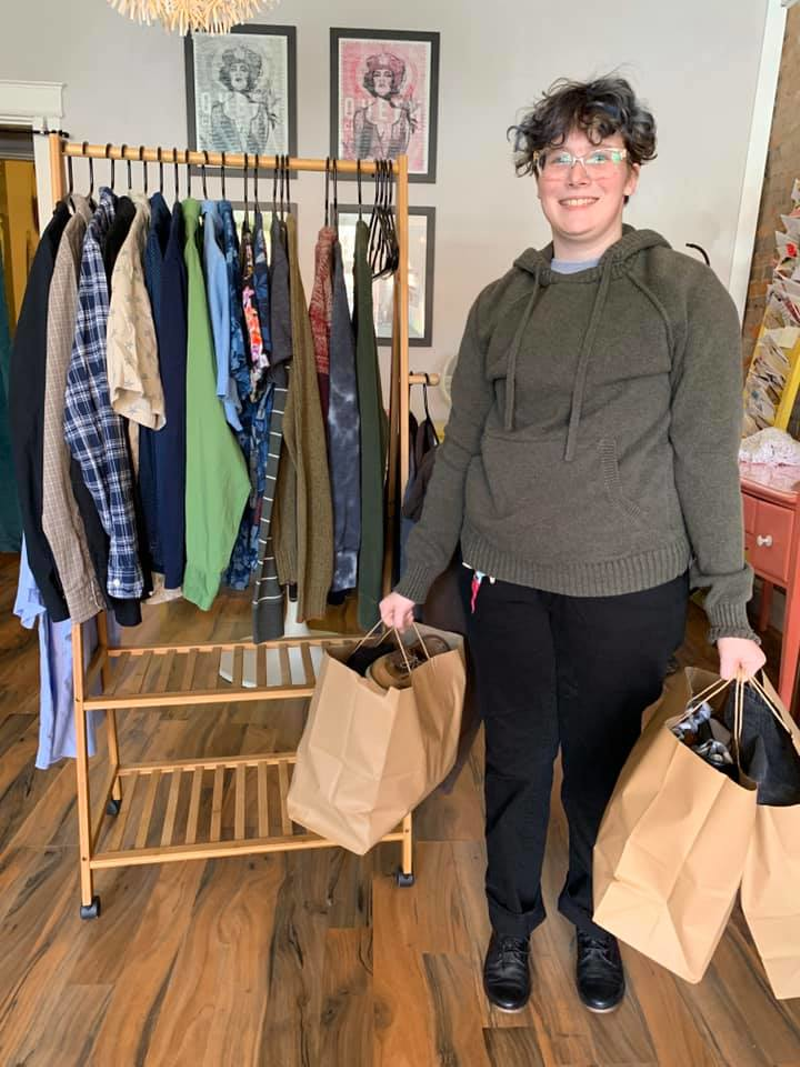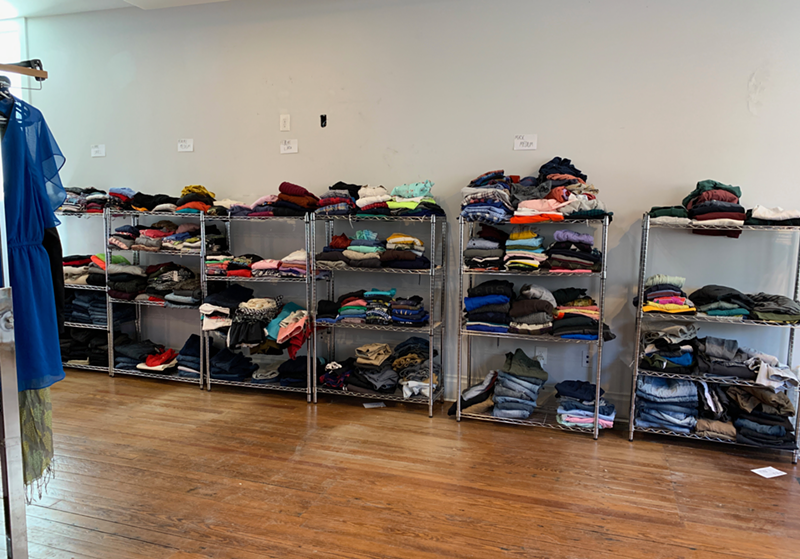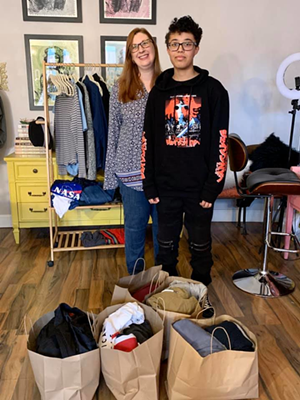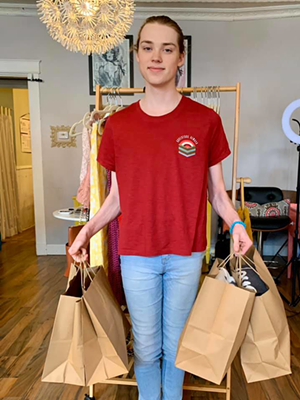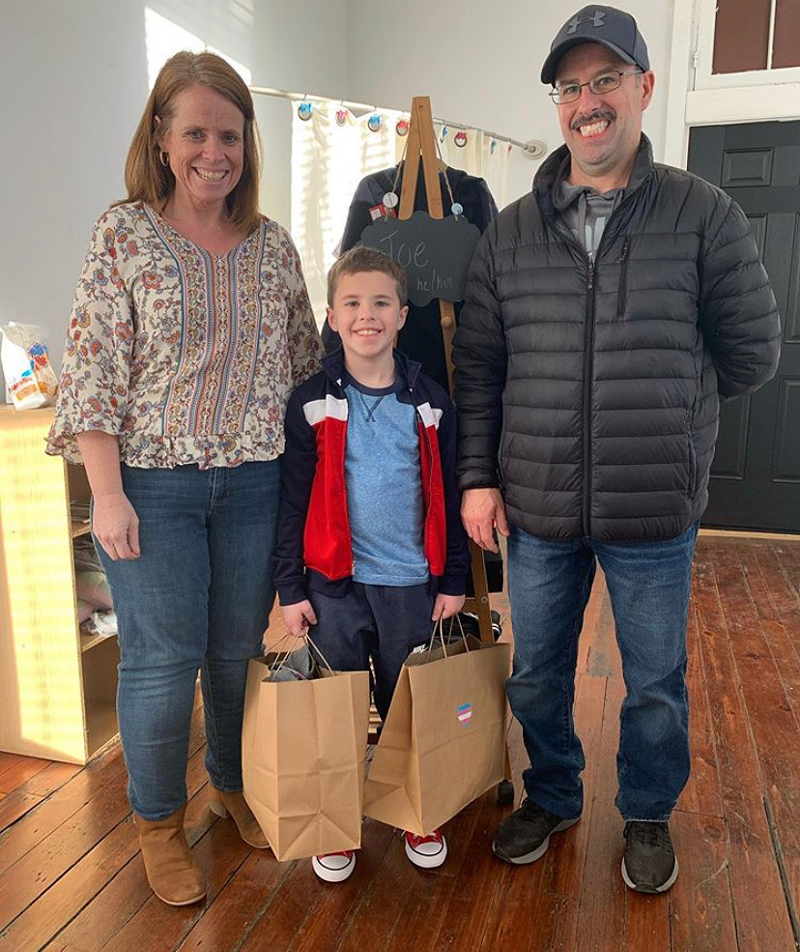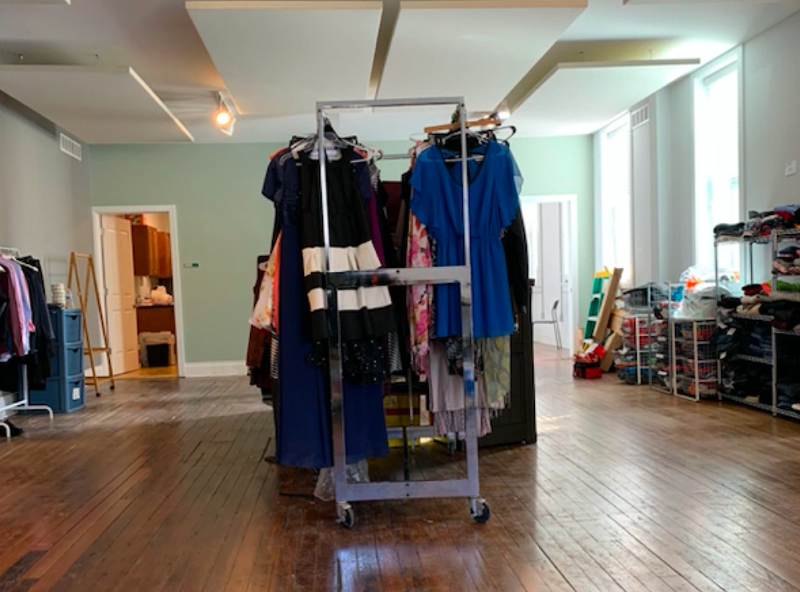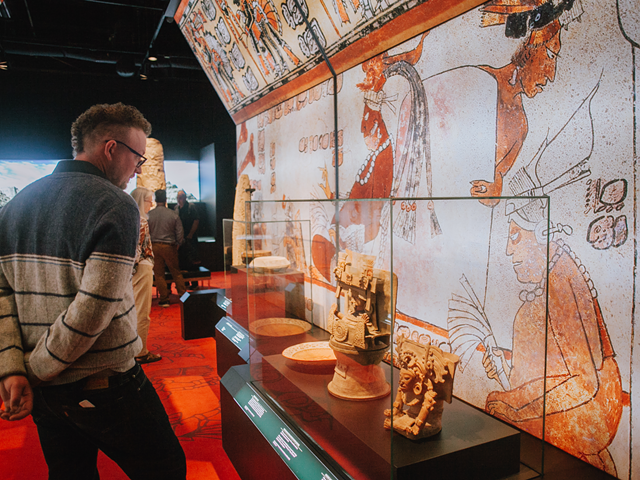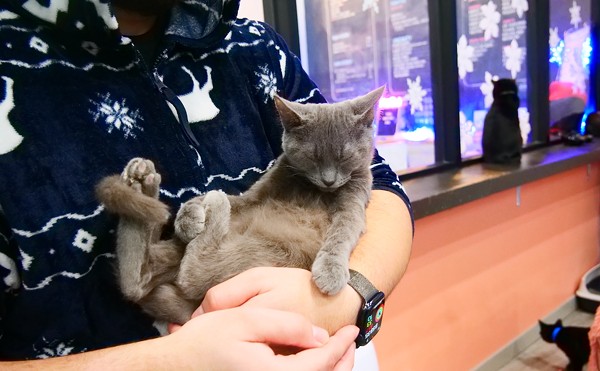By all accounts, Elliott Reed is a pretty typical 17-year-old. A high school senior, his days are occupied with school, friends, dating, working a part-time job at the mall and making plans for college. He wears band tees, black boots and a curly, more-on-top haircut synonymous with contemporary teenage boydom. Like generations of teens before him, his hair has been nearly more colors than he can name: black, blond, silver, pink, red.
“I’m about to dye it back to blue for senior pictures,” he says.
Reed is also transgender — one of the roughly 150,000 transgender teenagers in the United States, according to a 2017 study by The Williams Institute at the UCLA School of Law.
And unlike other teens, he was the first of a quickly growing number of young people to visit Transform, a Cincinnati nonprofit that provides clothing and individualized styling services to trans and gender nonconforming youth.
So far Transform has met with more than 30 kids and teens ages 6 to 18, with equally as many on a waitlist for appointments. Reed left his first appointment with not only bags of new outfits, but also having gained mentors, friends and an eagerness to continue a cycle of community and compassion.
While some nonprofits require months of planning before work can begin, Transform was born rapid-fire last September when Nancy Dawson and Tristan Vaught connected in the comments of a Facebook post about gender reveal parties.
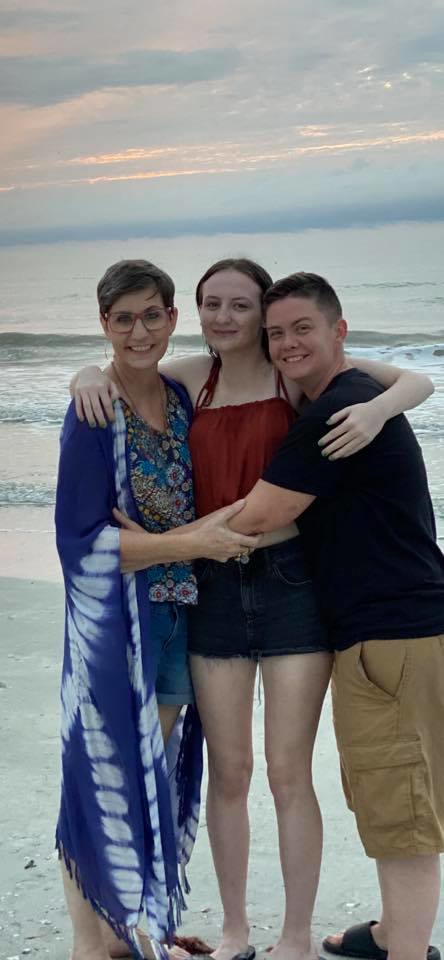
It’s a familiar concept, but there are plenty of viral videos across social media to introduce the uninitiated. Surrounded by family and friends, expecting parents reveal the gender of their new child in various forms — cakes are cut, piñatas broken, balloons dropped — typically unveiling something pink for a girl and blue for a boy.
The party antics also have a tendency to go awry: balloons float away, people are hit in the head by falling boxes and older siblings devolve into hysterics when the gender of the baby-to-be isn’t what they’d hoped. In 2018, one such party in Arizona even started a 47,000-acre wildfire when explosives meant to release colored smoke ignited.
Silly at least and outright dangerous at worst, Vaught — who is the director of training and education at Living With Change, a nonprofit dedicated to supporting transgender youth and their families at Cincinnati Children’s Hospital — shared a circulating post with an alternative for the infamous gender reveal: giving clothes to people undergoing gender transitions.
Dawson commented in agreement — one of her children is trans, and she’d already played with the idea of starting a clothing closet herself. Within the hour she was on FaceTime showing Vaught the space at her makeup boutique, BRIDEface. The back room previously rented out to another business was empty and there was plenty of space in the basement for clothing storage. It was settled.
Joined by Dawson’s 17-year-old daughter, Ella Dastillung, the Transform team got to work making their idea a reality. They took to Facebook to ask for donations of clothing, racks, storage bins and more necessary supplies, writing, “Let’s face it-when a kid transitions they need support, understanding, AND probably a new wardrobe that better fits their identity. Transform is a shop where kids can drop off their old stuff and swap it for new-with the help of teen stylists. We need a lot of stuff to get started!”
“Within a couple days people were just bringing bags and bags of stuff,” Dawson says. “People got it. They understood.”
Soon, that empty back room became a dressing room complete with a vanity, wall of wigs and clothing racks to be personalized to the tastes of each client. The basement quickly filled with floor-to-ceiling stacks of donations: everything from casual jeans to sparkly formal dresses to a cool shiny pair of red oxfords.
“We grew out of the space in like a week when we got so many donations,” Dastillung says. “We did not understand how big this was going to get so quickly.”
With Transform well underway, its co-founders and dedicated groups of volunteers are hard at work sorting donations, organizing appointments and devising plans for the organization’s progress — not least of all Dawson, who is managing a terminal cancer diagnosis on top of running a nonprofit (she recently sold BRIDEface to a friend).
Still, she keeps Transform in focus. In early January, the group launched a crowdfunding campaign to raise money for a new, dedicated location, which they found just up the block from BRIDEface on West McMicken Avenue in late February.
The campaign raised more than $47,000 in over 500 individual donations in its first week and a half, partially boosted by some high-profile names including Hamilton creator Lin-Manuel Miranda, director Ava DuVernay and late-night host Seth Meyers after Dawson’s husband, Matt Zoller Seitz, a film and TV journalist, wrote about the fundraiser on a Twitter thread documenting Dawson’s cancer diagnosis.
Support flooded in, and Transform’s vision for its future — and those of the youth they support — morphing from possibility to reality with each donation.
Self Expression
Growing up is not without its own challenges, especially when your gender identity doesn’t match how the rest of the world sees you. While kids can come out at younger ages, Reed didn’t realize he was trans until he had started high school.
“Looking back, I can see like, the little things that I did when I was younger that might have suggested it,” he says, citing his early insistence to use men’s deodorant and a scene involving a pair of scissors and the long, shiny hair of an American Girl Doll subsequently renamed from Emily to Luke.
It wasn’t until he was apparently “misgendered” at a restaurant that his perception of himself began to shift.
“I had this big hoodie on. We were in a Red Robin — me, my brother and my grandparents — and this waiter walked up to me and said ‘What can I get for you, sir?’ I was just literally blown out of the water. I was so excited. I was like, ‘Why am I so happy about this? Why am I happy that they just called me sir?’ As soon as my brother corrected them, my heart sunk.”
He suppressed the feeling until he first came out to a classmate nearly a year ago. Speaking it out loud for the first time — that no, he wasn’t a girl — was “terrifying,” he says.
Still, it was true. He’s not a girl. With parental support, he began wearing a chest binder and started testosterone replacement therapy, a masculinizing hormone treatment.
In October, Transform took Reed’s journey of gender expression another step forward, outfitting him with a new wardrobe and sending him on his way to Bishops unisex hair shop in Clifton, where the shop had offered free haircuts to Transform clients. (Bishops says on their Facebook page they will also offer $5 off any service when you donate $10 to Transform).
Within a single day, he had a brand-new look. He says he needed the new clothes, but more importantly the sense of confidence and empowerment in seeing himself as normal, accepted and supported, which he got and more.
“I kind of stared at myself in the mirror for way too long. It was like my self-esteem went up so far,” he says. “I couldn’t thank them enough.”
Lifelines
For trans and gender nonconforming youth, there are more barriers to self and societal acceptance than just clothing. Increasingly, Ohio state legislature threatens to limit gender expression and transition for minors.
In February, conservative lawmakers in the Ohio House of Representatives introduced a bill that would impose legal penalties on doctors who prescribe hormones or perform gender confirming surgery on trans minors, as well as one that would bar transgender students from participating on sports teams that match their gender.
Everyday struggles in schools are prevalent, too. According to the GLSEN 2017 National School Climate Survey, more than half of students reported being verbally harassed for their gender expression, and nearly a quarter were physically harassed because of their gender expression.
Reed himself has transferred high schools more than once, all the while dealing with bullying and mental health issues. He cites Transform not only for its inclusivity and empowerment, but also for saving his life.
“Transgender youth and transgender individuals in general are a very high-risk population,” says Sarah World, a licensed independent social worker specializing in clinical assessment and evaluation for gender dysphoria.
The clients she sees at Find Your Way Counseling & Consulting LLC, her private practice in Blue Ash, tend to struggle with dual anxieties: both about outward gender expression, including the perceptions of others, and the inner distress of having their identity not align with their body or the gender they were assigned at birth. That brain-body incongruence, she says, tends to increase mental health concerns including anxiety, depression and suicidal ideation.
“For trans youth and young adults, the suicide attempt rate — the most prominent and well-researched data — is around 41 percent,” she says, citing a 2018 study conducted by the American Academy of Pediatrics.
Data published by GLSEN also suggests that the lifetime suicide attempt rate for transgender people is up to 50 percent. Comparatively, the rate for the general U.S. population is roughly 4.5 percent, according to the 2018 National Survey of Drug Use and Health.
“That suicide attempt rate, depression and anxiety are most commonly directly linked to perceived levels of acceptance, predominately from family,” she says.
In 2014, the death by suicide of Leelah Alcorn, a 17-year-old girl transgender girl from Kings Mills, Ohio caught international attention after a note written on her Tumblr blog went viral. In it, she cited disapproval from her parents and explained she’d been sent to conversion therapy — a largely discredited and allegedly abusive practice aimed at changing an individual’s sexuality or gender identity that is now banned in Cincinnati and in 20 states.
“When I was 14, I learned what transgender meant and cried of happiness,” Alcorn wrote in the post. “After 10 years of confusion I finally understood who I was. I immediately told my mom, and she reacted extremely negatively, telling me that it was a phase, that I would never truly be a girl, that God doesn’t make mistakes, that I am wrong. If you are reading this, parents, please don’t tell this to your kids...That won’t do anything but make them hate them self. That’s exactly what it did to me.”
Alcorn’s death was marked by candlelight vigils and calls for more bans on conversion therapy across the U.S. Though her life ended tragically short, she was far from alone in her experiences with gender.
“In today’s society we have more young people coming out as transgender, and so there is a concern that it is trendy or that it’s a phase,” World says. “The teenage years are characterized by identity development. Right now, in our world, young people are more and more exploring their gender identity as part of their overall identity. It is a really normal, common variant of development to do that. Teenagers do go through phases. That doesn’t mean their gender identity is a phase.”
When Reed began his transition, he also began a happier, more authentic life. He chose a new name for himself and started using the correct pronouns.
“The first time I heard someone talk about me and use ‘he,’ it was amazing,” he says.
Despite the statistics, “a lot of trans people are really happy, well-adjusted humans,” says World. “What we don’t talk a lot about is gender euphoria...we all feel more confident and more comfortable when we can present ourselves outwardly in a way that feels authentic to us. That is a really human quality.”
The Power of a Thread
At the heart of Transform is a single, uncomplicated goal: give clothes to kids who need them. Dawson, whose youngest daughter Phoebe came out as trans when she was 10, knows the unique ordeal of trying to secure an entirely new wardrobe on a family budget.
“She still doesn’t know her style,” Dawson says of her daughter, who is now 15. “Teenagers alone go through many style evolutions. So you’re already flighty as hell, ‘cause you’re teenagers and you’ve been in the closet for 11 years.”
Plus, “you’re like fully programmed to hate whatever your mom likes.”
Luckily, older sister Ella has plenty of clothes to steal while she figures out her fashion sensibilities — likely evidence that teenage sisters are about the same everywhere, cis or transgender be damned.
Not all kids can snag shirts from siblings’ closets, of course. That’s where Transform steps in.
“For these trans kids, (Transform has) a wardrobe full of clothes that match their assigned sex,” World says. “Even if their parents are supportive, most people don’t have the income to be able to go out and buy a whole new wardrobe.”
The clothing and styling sessions are free, which means that Transform relies entirely on donations and volunteer help to stock their shelves. Weekly volunteer sessions are reserved for organizing donations. Some arrive as deliveries of gently used clothing, while other supplies come from donated purchases off their Amazon wishlist and special buying trips for items in greater demand like binders and new, gender-neutral shoes.
Luckily, the number of donations is in no short supply; Transform has even had to temporarily close donations for certain items due to the surplus, but they regularly post about what they’re currently accepting on Facebook.
Prospective clients fill out a form detailing everything from their gender expression to style preferences and clothing sizes. Then, a teenage stylist or two (frequently Dastillung or Reed, but there are a handful of other teens who volunteer their services) will hand-select items from Transform’s vast collection for clients to try out at their appointment.
After Reed, Transform’s second client was a teenager who drove three hours with her mom to make her appointment. Neither of them had ever met another trans person before.
Most clients are 13 or above, although the youngest so far was 8. The younger kids are some of Dastillung’s favorites. Unlike the mellow, mild-mannered teens, the little ones rush in with unbridled enthusiasm, cycling through quick changes fashion-show style.
Transform also offers a relief from the anxiety-inducing experience that is shopping in public. When Reed first transitioned, he had fears about shopping in the men’s section at stores.
Vaught, who is nonbinary and identifies as genderqueer, shares the same concerns as an adult. “I hate to go shopping,” they say, “because I’m like, ‘Do I go in the men’s changing room? Do I go in the women’s changing room? Do I drag all of these clothes that I’ve just gotten in the men’s section over to the women’s changing room just so someone can harass me while I’m in there?' ”
With a private changing area and individualized styling — where there are no gendered sections or prying eyes — clients can “shop” free of judgement and limitations, while also getting clothing advice and learning what cuts and styles of clothing look best on them, a task that takes a fair amount of time for anyone, no matter their gender.
Vaught has particularly good intel on where to get men’s pants for wider hips (Old Navy’s men’s jeans and the Goodfellow & Co brand at Target are the best) and Reed created a guide for first-time binder wearers (make sure it’s not too small and don’t sleep in it unless you want to risk cracked ribs).
The styling appointments are intertwined with vital support and affirmation for the young people who step through Transform’s doors.
“Transgender teens need some type of support system, some type of adult guidance, whether it be a teacher or parent or somebody who accepts and supports them,” Reed says. “That’s so controversial. It shouldn’t be but it is.”
A Lasting Legacy
Flourishing faster than its co-founders ever could have ever guessed, Transform is already well-rooted in fertile soil. Come what may, Dawson is securing plans for the future. She recently sold BRIDEface to a longtime friend and is still at work laying the foundation for her nonprofit to change the lives of youth in Cincinnati and beyond, long after it’s out of her hands.
In January, she wrote of her community’s support for the project: “Every puzzle piece almost effortlessly fell into place because the project spoke to people. People were just coming to me and dropping things in my lap before I had the chance to ask, and volunteers showed up in droves and stayed...we are dreaming big big.”
Those big, big dreams began to take effect when Transform moved into a new, 1,500 square foot space in Over-the-Rhine, which will serve as the organization’s temporary hub until they find a permanent, forever home for exponential growth. Much more than just a clothing closet — although that will always remain Transform’s top priority — Dawson imagines a haven with room for a storefront and styling appointments, hangout spaces for LGBTQ youth, offices and room to host education, counseling and community.
While many colleges have dedicated LGBTQ centers, there aren’t many options for kids and teenagers outside of youth groups. These groups can be “lovely” and “super fun,” says Reed, but also “just a mess of everybody dating everybody,” he adds with a laugh.
Regional organizations like Kaleidoscope Youth Center in Columbus and Indiana Youth Group in Indianapolis offer more resources: sewing clubs, tutoring sessions, movie marathons, HIV and STI testing and karaoke nights are all on the calendar along with opportunities for identity-based support. There’s a gap for something similar in Cincinnati that Transform aims to fill.
“There’s no space just to hang out and be like, ‘I’m going to do my homework in a space where there are people that look like me,’ ” Vaught says. “I used to work with college kids. They’re like, ‘I feel like I’m wearing armor all day long, and when I get to the (LGBTQ) center I’m able to take it all off and just be.’ High school kids are going through the same thing, middle school kids are going through the same thing, but they don’t have those spaces.”
Securing greater funding is also on the docket. Transform is currently a charitable organization with Community Shares of Greater Cincinnati’s Workplace Giving program, which allows employees to make donations through their employer. Their ultimate goal is to earn a corporate philanthropic sponsorship or grant from the likes of Western & Southern Financial Group, the Fifth Third Foundation or The Carol Ann and Ralph V. Haile, Jr./U.S. Bank Foundation, which fund other charitable organizations in Cincinnati.
As for the youth themselves? They have big plans, too.
Reed is working on graduating early and enrolling at the University of Cincinnati as soon as possible. He’s staying close, opting for UC over Miami University for its proximity to his newfound community at Transform. Long-term, he’d like to work as a history teacher in rural communities and set a positive example for other LGBTQ and minority kids.
“(Transform has) made me realize that I want to be able to help people and support LGBTQ teens, no matter where they are, no matter what kind of stage they’re in and just be a supporting role for them.”
A high school senior herself, Dastillung plans on taking a gap year after graduation with her sights set on continuing her mother’s work through Transform and reaching as many young people as possible. The team has gotten plenty of comments and questions about expanding the nonprofit in other cities. While they’re still getting off the ground in Cincinnati, they’re not ruling it out for down the road.
“The exciting thing about Transform is that it’s not that hard to start one,” Dawson says. “If you’ve got the donations, it can be totally self-sustained.”
The truth of it is undeniable: with a simple idea, some community support and a bit of ingenuity, Dawson, Dastillung and Vaught were able to start their own small project that will continue to thrive for the foreseeable future.
“I absolutely see Transform as being one of my legacies, along with my children,” Dawson told TODAY in a news segment about the nonprofit. “There’s a line from Hamilton that is about planting seeds in a garden you never get to see. That’s kind of what I see for Transform.”
For more information about Transform, including how to donate, volunteer or support the mission, as well as become a client, visit transformcincy.org.

